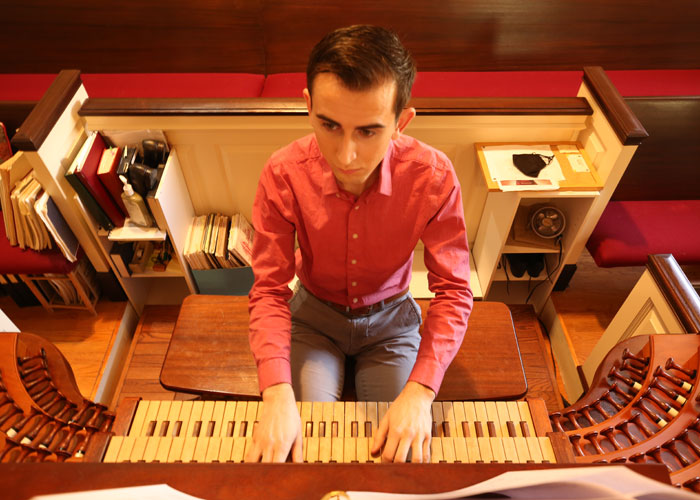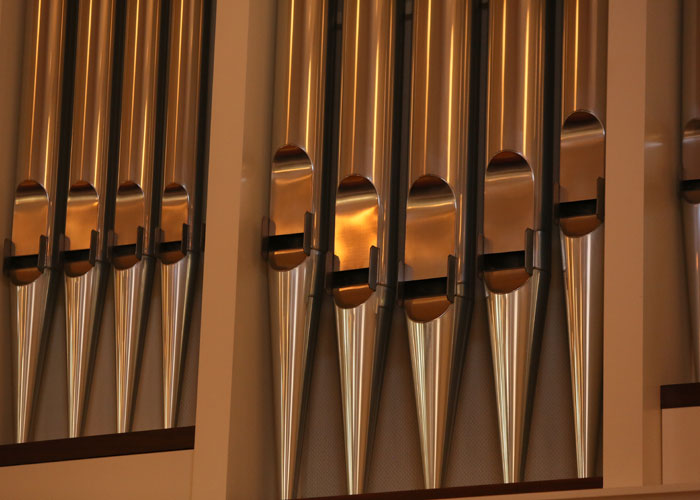Like lots of people undertaking projects during the pandemic shutdown, Colin Carmody ’22 finally had time.
Carmody, double majoring in music and math at William & Mary, had long been interested in his great-great-grandfather’s compositions for organ. That family member, William H. Oetting, worked as a church organist and music teacher who helped found what is today the University of Pittsburgh Department of Music.
Carmody decided one piece was of particular interest and looked up the composition, which is held along with Oetting’s works in the University of Pittsburgh’s music library. After spending the shutdown combining three versions into one and smoothing out the score to Sonata in G minor, Carmody has spent months rehearsing it in preparation for performing the piece at his senior recital on Feb. 26 at 3 p.m. at Williamsburg United Methodist Church.
Carmody also will play the piano and harpsichord during his recital, but the organ composition will be especially significant.
Among the family members and friends traveling from Northern Virginia or watching remotely when he plays the new piece will be Carmody’s grandmother — Oetting’s granddaughter and an accomplished pianist. Also special is that few family members have heard Carmody play the organ or harpsichord because during the pandemic it’s been more difficult to travel to Williamsburg.
“I am excited to be able to play his work and to give, I guess you could call it, the world premiere of it,” Carmody said “since as far as I know, the composer — my great-great-grandfather — was the only person ever to have performed it apart from what will be me.
“It means a lot to know that my grandmother will be in the audience, so the composer’s granddaughter. … because I’ve been talking with her throughout this whole process and sharing things with her. And so I think she’s super excited, and it will mean a lot to share that.”
Music Instructor Tom Marshall, in his 40th year of teaching, helped Carmody learn the composition and tweak the intricacies during organ lessons. Marshall described the piece as “a grand, lavish three-movement work for solo organ.”
“In addition to having the experience of teaching a terrific student to play organ better, it has been my unique experience watching Colin discover, unfold, edit and learn to play an unpublished organ sonata of his great-great-grandfather, William Oetting,” Marshall said. “This exciting and beautiful music needs to be joined with the mainstream of the most extensive literature for any instrument, extant examples dating from the 1300s to the present.
“Colin has prepared a unique senior recital presentation playing three keyboard instruments in showing what he has accomplished as a serious student here at William & Mary. Helping to guide Colin’s final efforts with this music has been pure joy.”

Working together on it for countless hours, Carmody said that he and Marshall know the piece inside and out.
He’s been so instrumental in helping me put this all together, both as a motivator but also as an advisor on this project,” Carmody said.
Talking with family members, Carmody gathered that many of Oetting’s compositions had been passed down within the family. But most everything now is in the University of Pittsburgh music library’s special collections.
Carmody visited the library while making his college visits during high school and saw huge stacks of Oetting’s papers there. Now that they have been digitized, he accessed the musical score online to start his project.
Carmody, who also sings in several groups as well as playing instruments, has taken after his very musical family. He began piano lessons at age 5 and took up the organ during high school, which is when he started researching Oetting’s work.
He has found at least 50 pieces, most of which are unpublished.
“It means so much to me since I have that family connection to it,” Carmody said. “He has a smaller repertoire of works just because he, I think, started with some composition and would do a little bit here and there since he was a church organist, as was his father and grandfather.

“And so he’d do a little bit for the church here and there. But for the most part, he was a music teacher. He helped found what’s now the University of Pittsburgh school of music. And so his main job was to teach music, rather than compose.”
Family members give the impression they all thought of Oetting as a composer, rather than a teacher, Carmody said, even though all of the research points to teaching as his main profession and source of income.
Carmody started his work on the three-movement Sonata in G minor by making a hard copy of each of the three versions he found. He made notes for small revisions, and then typeset all of the notes to make a complete list.
“There are certainly changes, but it is fairly similar,” Carmody said. “Once I had that first one, it then became easier to edit the second one based upon what I had already done with the first one and then to do that with the third edition.”
Oetting started composing the piece in 1900 while studying in Berlin for a year. He wrote the third version, adding a revised third movement, in 1919. Oetting started composing the piece in 1900 while studying in Berlin for a year. He wrote the third version, adding a revised third movement, in 1919.
In analyzing the notations on the scores of the three versions, Carmody thinks he has pieced together the order Oetting wrote them in, and that at least some of the notes were accounting for playing on different organs.
“I’ve put together my own edition that summarizes all of them,” Carmody said. “Interestingly version three, as it’s called on the website, has a completely different third movement than the other two versions of it.
“I suspect he didn’t really have an idea. And later when he came back and was reworking things, he said oh, I know what I want to do here. And he had an idea for a new third movement and replaced it.”
Carmody is looking into possibly having the piece published.
“If published, I would love to hear other organists playing it around the country, maybe around the world,” he said. “But it could definitely be cool if there are other interpretations that come after me.”

Carmody composed for his music department honors project a work for orchestra that he is conducting and will be performed in March, and last fall he won first place in the Virginia Music Teachers Association College Division Concerto Competition. After graduating, he plans to consider graduate schools.
“I’m interested in looking at either my own music composition or music theory degree in such a way that I can combine music with math,” Carmody said, “since there have been a number of mathematical works behind musical approaches or approaches to music.
“So that’s what I’m interested in, which in some ways is a little different than this particular project since that was not at all the approach taken by my great-great-grandfather. But to research his music in some ways I feel helps to connect me a little bit more to the existing musical world that’s out there.”
Jennifer L. Williams, Communications Specialist

